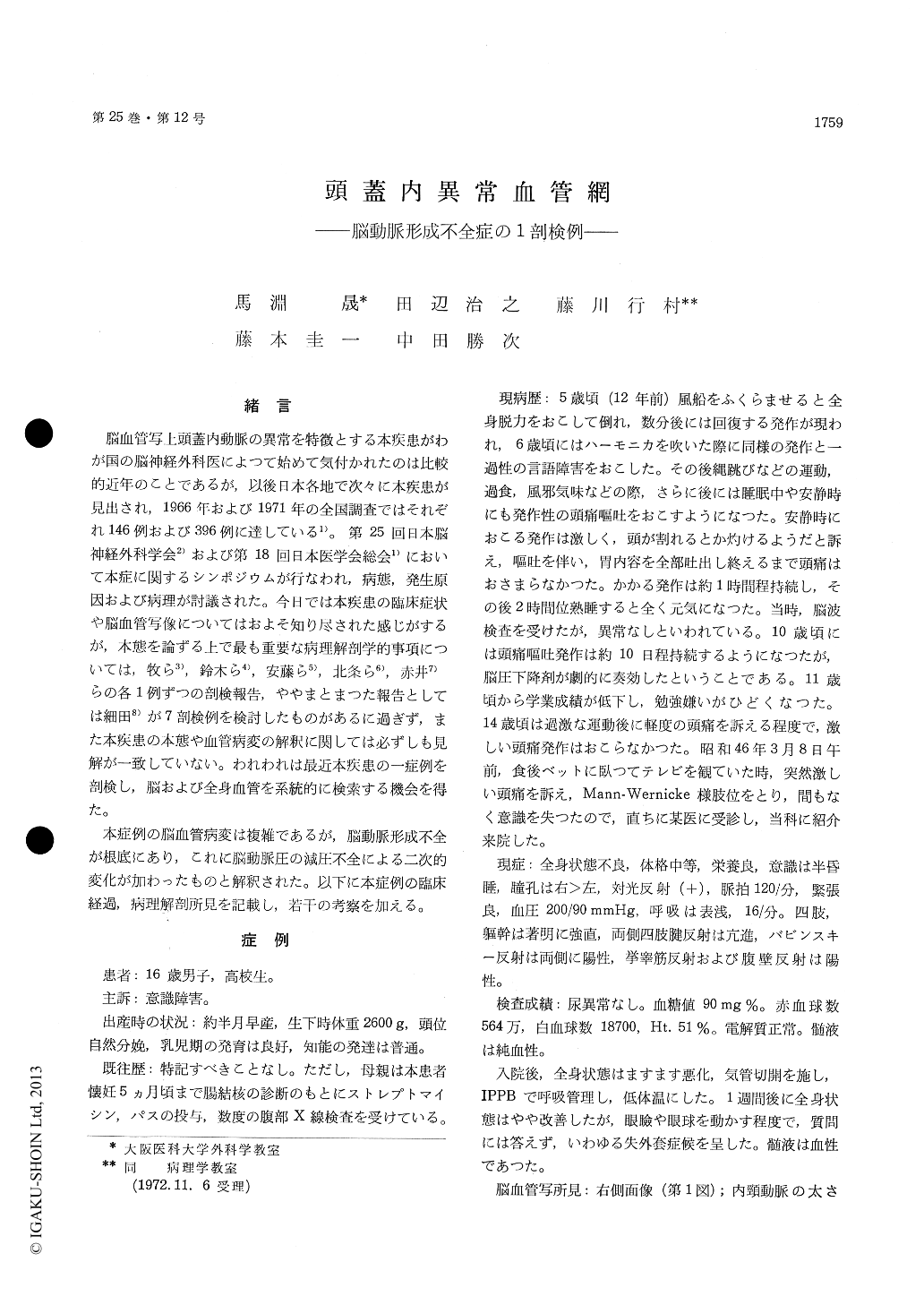Japanese
English
- 有料閲覧
- Abstract 文献概要
- 1ページ目 Look Inside
緒言
脳血管写上頭蓋内動脈の異常を特徴とする本疾患がわが国の脳神経外科医によつて始めて気付かれたのは比較的近年のことであるが,以後日本各地で次々に本疾患が見出され,1966年および1971年の全国調査ではそれぞれ146例および396例に達している1)。第25回日本脳神経外科学会2)および第18回日本医学会総会1)において本症に関するシンポジウムが行なわれ,病態,発生原因および病理が討議された。今日では本疾患の臨床症状や脳血管写像についてはおよそ知り尽された感じがするが,本態を論ずる上で最も重要な病理解剖学的事項については,牧ら3),鈴木ら4),安藤ら5),北条ら6),赤井7)らの各1例ずつの剖検報告,ややまとまつた報告としては細田8)が7剖検例を検討したものがあるに過ぎず,また本疾患の本態や血管病変の解釈に関しては必ずしも見解が一致していない。われわれは最近本疾患の一症例を剖検し,脳および全身血管を系統的に検索する機会を得た。
本症例の脳血管病変は複雑であるが,脳動脈形成不全が根底にあり,これに脳動脈圧の減圧不全による二次的変化が加わったものと解釈された。以下に本症例の臨床経過,病理解剖所見を記載し,若干の考察を加える。
In this paper, a case of the abnormal vascularity of the intracranial arteries (so called Moya Moya disease) was reported. The patient, 16 years old Japanese boy, had frequently complained of head-ache and disturbance of consciousness since his childhood. He had precipitious onset of severe headache and lost consciousness at March 8, 1971, and the physical examination proved the subarach-noideal hemorrhage. He died without recovering his consciousness 14 months after. The cerebral angiography revealed the characteristic configula-tion of the intracranial arteries such as ; narrowing of the bilateral internal carotis arteries at the base of cranium and marked winding of small arterial branches without normal distribution of the cerebral arteries. The post morten examination showed the dysplasia of the cerebral arteries characterized by the following findings ; 1) the large arteries at the base of the brain, except for the A. basilaris and Aa. vertebrales, were extremly small, 2) they branched abruptly to numerous bush-like smallarteries, thus it was unable to trace their course to the periphery, 3) the wide spread softening of the entire brain. Histology revealed ; 1) a- or hypoplasia of the media of arteries in the brain, non of which was found in the other organs, 2) discontinuity of the internal elastic lamellae in some arteries, 3) marked edematous thickening or fibrous thickening of the inner wall of the arteries without inflammatory cell reaction, which resulted in marked stenosis of the vessel lumen, 4) marked winding and thickening of the elastic fiber in manyarteries, and 5) a recent and old ischemic necrosis of the brain. It was considered that lacking or hypoplasia of the medial layer was of congenital (dysplasia) and was the essential vascular lesion of the present case. The other vascular lesions such as edema and fibrosis of the intimal layer, winding and proliferation of the elastic fiber must be a result of insufficient reduction of arterial blood pressure.

Copyright © 1973, Igaku-Shoin Ltd. All rights reserved.


